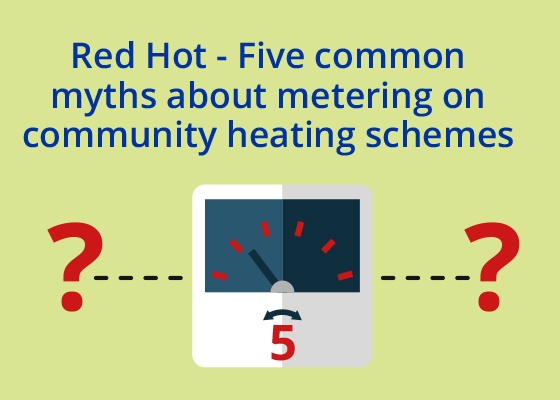- Home
- / Knowledge Base
- /
- / Common Myths about Metering & Heating Schemes

Discover the practical and legislative arguments for installing meters and pay as you go (PAYG) for users of district and communal heating.
The use of heat meters and PAYG is a logical (and meters are now a legally-required) consideration when planning a community or district heating scheme. But some common myths about metered heat still prevail....
Red Hot - Five common myths about metering on community heating schemes
 There are many misunderstandings about community heating schemes, especially when it comes to heat metering and pay-as-you-go (PAYG).
There are many misunderstandings about community heating schemes, especially when it comes to heat metering and pay-as-you-go (PAYG).
Read on to uncover the truth behind five common misconceptions.
Myth 1: A question of cost
"Installing heat meters only cuts 20% from bills."
Not true
In fact, residents who only pay for what they use often find they are paying 30-50% less for their heating bills when they move from flat-rate billing.
"We are installing new heat meters to help our tenants save money and have more control over their heating bills."
Councillor Jayne Dunn
Cabinet Member for Housing at Sheffield City Council
Council tenants set to save more than £1.4 million in heating bills
Myth 2: A flat-rate is better
"Flat-rate charging is the better option and a solution to fuel poverty."
Only part of the equation
Paying the same amount each month does have its benefits, but the fact that metering can actually reduce the overall cost of heat by up to 50% - and help to address fuel poverty - shines a light on flat-rate charging.
"I am very happy with the new meter and it is costing me less to heat my home."
James & Debbie, residents in Sheffield, managed bySheffield City Council
Myth 3: Fuel theft
"It’s easier for people to steal heat from a metered service."
An over-heated argument. Meters are perfectly secure as long as they are properly managed and policed by scheme operators. If non-payment does rise then PAYG can be introduced alongside a heat meter to protect the landlord against debt risk. Residents can benefit from the greater transparency this offers as well.
"The functionality offers residents more information which puts them in control of their heating through access to consumption graphs and charts."
Karl Slater, Revenue Accountant, WDH (Wakefield District Housing)
Myth 4: A threat to health
"Vulnerable residents could die of hypothermia if they are metered for heat!"
Scaremongering
The reality is that the opposite should be the case. Landlords can keep track of usage and payments of metered residents and step in if they appear to be struggling. Not only that, more transparent billing means older residents can decide exactly how much money to put towards heat from their pensions.
"Since taking over the billing on the scheme, residents are receiving regular accurate bills which helps with their budgeting as it makes them aware of usage."
Craig Robinson, Head of Property accounts, Family Mosaic
Myth 5: More expensive
"Pay-as-you-go costs more than credit billing."
Nothing more than an empty headline
You'll find operating costs on PAYG schemes are the same as other metered schemes. The kWh charge on PAYG is not higher than credit billing either - our experience running 400 schemes shows that PAYG and credit billing tariffs are the same.
Yes, PAYG units do carry a capital and installation cost, but the payment method offsets the debt risk for landlords and give residents more control over their bills.
"With PAYG customers being able to see their credit status and top up easily, it is a vast improvement and much more convenient. The new metered system is flexible, enables residents to budget better and potentially make savings on their heating bills."
Karl Slater, Revenue Accountant, WDH (Wakefield District Housing)
Get to grips
The new Heat Network Regulations at a glance:
|
December 2014: |
Duty introduced for suppliers to start gathering information on each community or district heating scheme. |
|
April 2015: |
Duty to comply with all aspects, including bulk metering and billing. |
|
December 2015: |
Deadline to notify the NMRO of all gathered information. |
|
December 2016: |
Deadline for completing installation of meters for each final customer. |
|
2019: |
Repeat the notification process and plan to do the same every four years. |
For more information, take a look at our eGuide: A Detailed Guide to the Heat Network (Metering and Billing) Regulations 2014
Food for thought
Would you expect to move into a new house without gas and electricity meters?
Should it be any different for heat?
PAYG meters may cost a little extra to install – but they are cost effective over time, eliminate debt exposure, and boost residents’ peace of mind… and that’s no myth.
Takeaways:
Heat meters:
- Can help residents save up to 50% off their bills
- Are tamper-proof and secure if properly managed and policed
- Help reduce fuel poverty by reducing bills
- Allow landlords to keep an eye on vulnerable tenants’ heat usage and payment ability



Add a comment